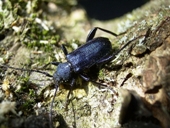Violet longhorn beetle (Callidium violaceum)
The violet longhorn beetle (Callidium violaceum) is another member of the longhorn family, which is found on dead barked trees and freshly felled coniferous timbers, especially spruce and pine.
The damage tends to occur in sawmills, wood stockpiles or in wood processing plants. They only occur in houses, if infested timbers have been used in their construction or in any wooden furnishings. They do not, however, cause any real damage. Mass reproduction in buildings can be ruled out as these beetles do not attack dry wood which has already been processed.
What does it look like?
The violet longhorn beetle is between 8 and 16 mm long and is basically black but with shiny dark-blue to violet wing covers. Its legs are very dark brown and the thighs are thin at the base, thickening out in a drumstick shape. In the final phase, the larvae are up to 2 mm long, their bodies are ivory coloured and divided into several ring-shaped abdominal sections.
How does it attack the wood?
The female lays her eggs in fine cracks in the bark of dead or felled trees. The larvae develop and grow between the bark and the wood, where they make flat frass galleries. They live there for about two years. For pupation, the larvae gnaw a pupation chamber (L-shaped) into the wood. The beetles hatch between April and July, leaving oval-shaped exit holes with a longitudinal diameter of 4 – 6 mm.
What damage can it cause?
As the larvae prefer feed on the cambium layer between the bark and the wood during their development, they do not gnaw any deep galleries into the wood. Though for pupation, they do burrow an L-shaped pupation chamber to a depth of about 50 mm into the wood, this does not normally lead to any weakening of structural components. As they deposit their eggs on fresh, barked wood, there is no risk of renewed infestation of dry wood by the violet longhorn beetle.
